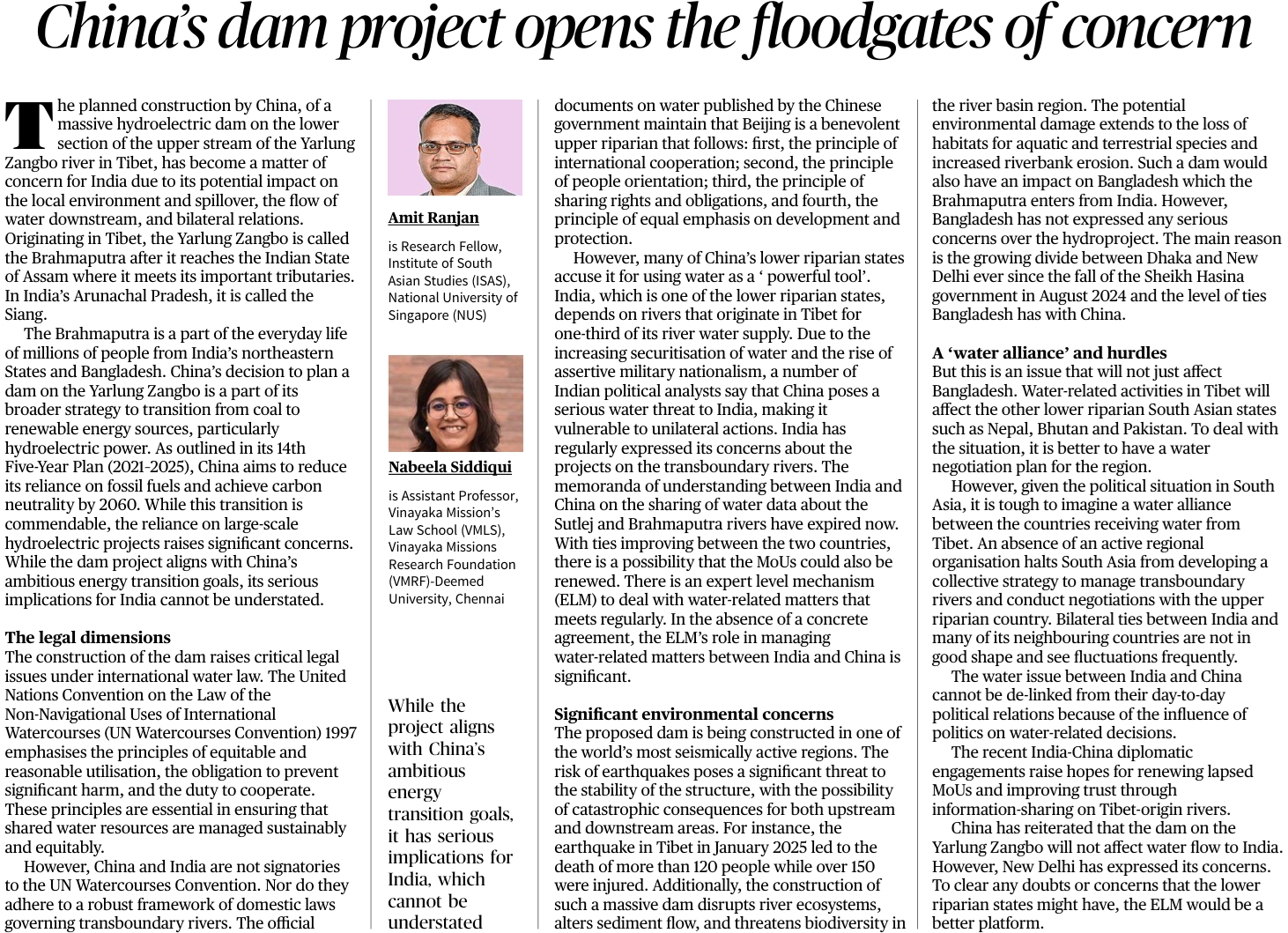1. China’s Brahmaputra Dam Project: Strategic and Environmental Concerns
Introduction
China’s planned construction of a massive hydroelectric dam on the Yarlung Zangbo (Brahmaputra) in Tibet has raised concerns for India and other lower riparian states. The dam is part of China’s broader energy transition strategy, but it poses legal, environmental, and geopolitical challenges, particularly for India and Bangladesh.
- Strategic and Legal Dimensions
- The dam project aligns with China’s 14th Five-Year Plan (2021-2025) for reducing reliance on fossil fuels and achieving carbon neutrality by 2060.
- However, transboundary water sharing issues raise legal and geopolitical concerns.
- The UN Watercourses Convention (1997) emphasizes equitable and reasonable utilization, but neither China nor India are signatories.
- China claims to be a benevolent upper riparian but has been accused of using water as a ‘powerful tool.’
- India depends on Tibetan-origin rivers for one-third of its water supply, making it vulnerable to China’s unilateral actions.
- The lapse of water-sharing Memoranda of Understanding (MoUs) between India and China adds to uncertainties.
- Environmental Concerns
- The dam is being built in a seismically active region, increasing the risk of structural instability.
- Earthquakes in Tibet have previously led to significant destruction, such as in 2025.
- The dam could disrupt ecosystems, threaten biodiversity, and impact river flow patterns.
- Bangladesh, which also depends on the Brahmaputra, has remained largely silent due to its growing ties with China.
- Regional and Diplomatic Implications
- The project could also affect Nepal, Bhutan, and Pakistan, making it a broader South Asian concern.
- The lack of an active regional water-sharing framework in South Asia hampers collective diplomatic efforts.
- The water issue remains politicized and linked to broader India-China tensions.
- India has raised concerns, but China claims the dam will not divert water.
- The Expert Level Mechanism (ELM) remains the only active bilateral forum on water-related issues.
Conclusion
China’s Brahmaputra dam project underscores the need for a regional water-sharing agreement and a de-politicized negotiation framework. The project highlights the geopolitical vulnerabilities of lower riparian states and the necessity for India to strengthen diplomatic and strategic mechanisms to safeguard its water security.
Bottom of FormMains Practice Question |
Q. China’s hydroelectric projects on transboundary rivers pose a strategic and environmental challenge to India. Discuss the legal, geopolitical, and environmental implications of China’s dam projects on the Brahmaputra. How should India respond? |
1. Ad-Hoc Judges in High Courts: A Solution to Judicial Backlog?
Introduction
The Supreme Court has permitted High Courts to appoint retired judges on an ad-hoc basis to address the increasing backlog of cases. With over 62 lakh pending cases as of January 2025, judicial delays have become a major concern. While the move aims to expedite case disposal, concerns exist regarding judicial independence, appointment procedures, and systemic reforms.
- Need for Ad-Hoc Judges
- The Supreme Court recognized the necessity of ad-hoc judges in its 2021 ruling in Lok Prahari v. Union of India.
- High Courts are burdened with a massive backlog of cases, causing delays in justice delivery.
- The appointment of ad-hoc judges could reduce financial strain on the government due to overcrowded jails and pending criminal appeals.
- Challenges in Appointing Ad-Hoc Judges
- Appointment Process Complexity: Requires presidential approval, impacting the efficiency of the process.
- Government Cooperation: The executive’s willingness to cooperate in timely appointments is uncertain.
- Selection Criteria: Identifying retired judges with impeccable integrity and expertise is crucial.
- Impact on Judicial Progression and Independence
- Career Progression of Sitting Judges: Ad-hoc judges serve for a limited tenure and do not compete with sitting judges for promotions. Their role does not impact the elevation of service judges in the judiciary.
- Judicial Independence: While concerns exist, retired judges’ limited tenure and lack of career elevation reduce risks of executive influence. However, financial incentives may determine whether retired judges prefer arbitration over judicial reappointment.
- Feasibility and Effectiveness
- The government must ensure that ad-hoc judges are appointed in a streamlined manner.
- The judiciary requires additional infrastructure and resources to accommodate ad-hoc appointments effectively.
- While a temporary measure, this move must be complemented by broader judicial reforms to improve case management and disposal.
Conclusion
The appointment of ad-hoc judges is a step toward addressing judicial backlog but is not a substitute for long-term structural reforms. The process must be simplified, and the government must ensure timely cooperation. A well-implemented ad-hoc system can help deliver justice efficiently without compromising judicial independence.
Mains Practice Question |
Q. The AI Diffusion Framework introduced by the U.S. seeks to control AI technology exports. Discuss its implications for global AI leadership and its impact on India’s technological and strategic interests. |



